The Birth-and-Death Twins: the fear of death can be eased by the Mindfulness of Death
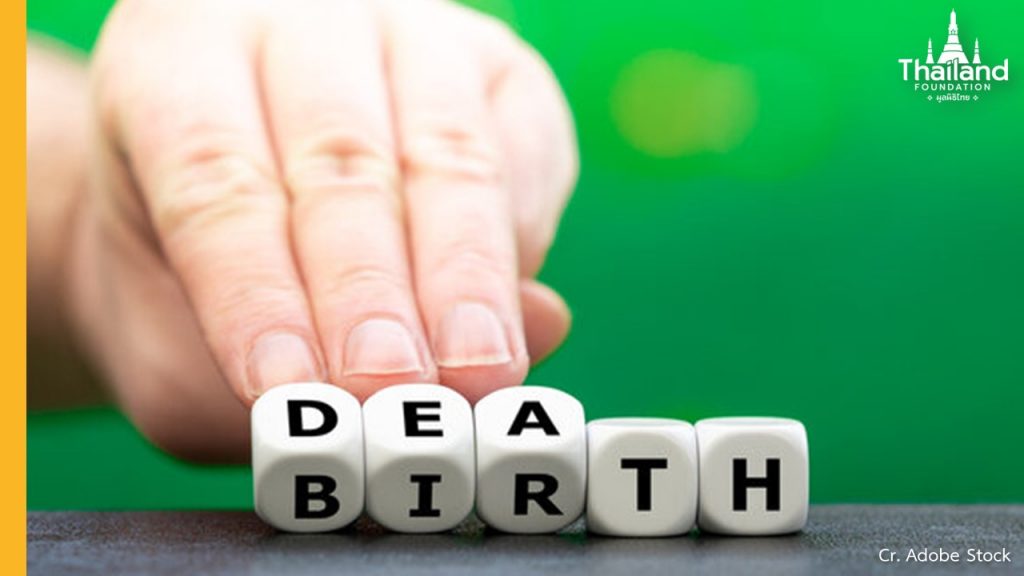
Introduction
In the Buddha’s teaching of an eternally repeated cycle of birth, life, and death (Samsara in Pali), birth and death are the natural twins that happen to all mortals – but at two different times. Death is not viewed as the end, but as a transition to the next rebirth in a new form in any of the 31 different planes/realms/worlds of existence. The Buddha taught that we should not have a fear of death, but instead should realize that death is naturally inevitable, and then for the rest of our lives, we should do our duties diligently, saying, “With days and nights passing by, one’s lifetime is getting shorter and shorter. One should, therefore, live heedfully and fulfill one’s duties. And one should have no fear of death.” He even prescribed a formula called Mindfulness of Death (Maranasati in Pali) for monks to overcome the fear of death and to constructively prepare for it.
At the outset, I also wish to say that more than 2500 years ago the Buddha taught Mindfulness of Death to monks, in order for them to train their minds to think in a certain way. The aim was for the monks to be able to recollect death, so that they could develop the perception of impermanence, to eradicate the attachment to life, to attain Jhanas, and finally to obtain Nibbana or Nirvana. Modern scientists have now heard of it, tried it and found that Maranasati can effectively train the mind of a person who is engrossed in the concerns of this present world on emotional management. Some of Maranasati’s many benefits include lessening death-related anxiety, sadness, and fear of death; helping people accept the idea of eventual death as a natural part of life; creating reflection and priorities in life; increasing appreciation of life; improving relationships with others and make the most of the time we have together; and increasing motivation for personal growth and development, as we recognize the impermanence of our lives and the importance of making a positive impact in society.
Therefore, there are two levels of practice of Mindfulness of Death and two levels of desired results. We all should practice Maranasati for emotional management.
Stages in Life of Human Beings
In order for us to better understand the Buddha’s teaching of Mindfulness of Death in daily life and make use of it, we may view our lifetime on earth in three stages, namely birth, life, and death. The three stages become a cycle – the cycle of birth, living, and death that every living thing must experience.
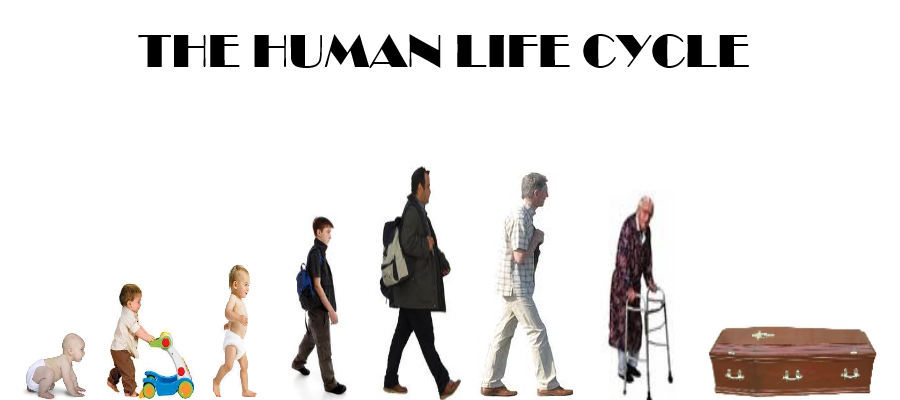
(Photo credit: https://bit.ly/42YcAVa)
People usually treat or react to these stages differently – but mainly to make themselves happy. And it is common that we behave so because we love happiness and hate suffering; we prefer acquisition to loss.
The First Stage: The Joy of Birth
At the time of birth, it is natural for us to have joy of birth, which is a powerful emotion experienced by parents, family members, and loved ones at the arrival of a new baby. Some reasons for the joy of birth are that the arrival of a baby represents a fulfillment of a dream of having a child, the continuation of the family line, and hope for the future. It also brings people together and provides an opportunity for family and loved ones to connect and bond over the new addition to the family. It even creates a sense of happiness and joy among the family members through Oxytocin. This ‘love hormone’ is responsible for the love you feel when you spend time with your baby. It’s a two-way street: your baby is releasing some oxytocin during those interactions too, and is enjoying the same bonding experience.

(Photo credit: https://bit.ly/3zcrhGI)
After birth, human beings have a life to live. According to Life Expectancy of the World Population, the estimated global average life expectancy at birth in 2020 was around 73.2 years, with females being 75.6 years, and males 70.8 years. As for Thailand, the average life expectancy in the same year was 77.74 years, with females being 81.34 years, and males 74.16 years.
Animals like cows have a lifespan, too. They naturally live as long as 15-20 years, sometimes more.
The article What Biology Tells Us About the Acceptance of Life and Death tells that life is about the transition from being born to having to die. Dying makes new life possible. Is there a way of using this knowledge to accept the transitory nature of ourselves and our loved ones?
Even non-living things like bulbs also have a lifespan. For example, incandescent lightbulbs generally have the shortest lifespans. The average incandescent bulb light span is approximately 1,000 hours. Fluorescents are a long-lasting option, running for anywhere from 15,000 to upwards of 20,000 hours.
There is, therefore, time for both living beings and non-living things to literally “live” or “exist” in this world. There is no permanent life or existence for anyone or anything.
This is the fact that we should fully understand and accept.
The Second Stage: The Meaningful Living
Realizing that we have a lifetime in the world, we should live a heedful and wholesome life, which requires intentional effort and a commitment to cultivating positive habits and attitudes so that we can live a good life for ourselves and others in the society simultaneously. For example, we should:
- Practice mindfulness meditation and here for a happy and successful life.
- Practice loving-kindness meditation for our own good and the good of society.
- Cultivate gratitude;
- Nurture positive relationships;
- Take care of our body;
- Practice self-compassion;
- Engage in activities that bring us joy;
- Live in alignment with our values.
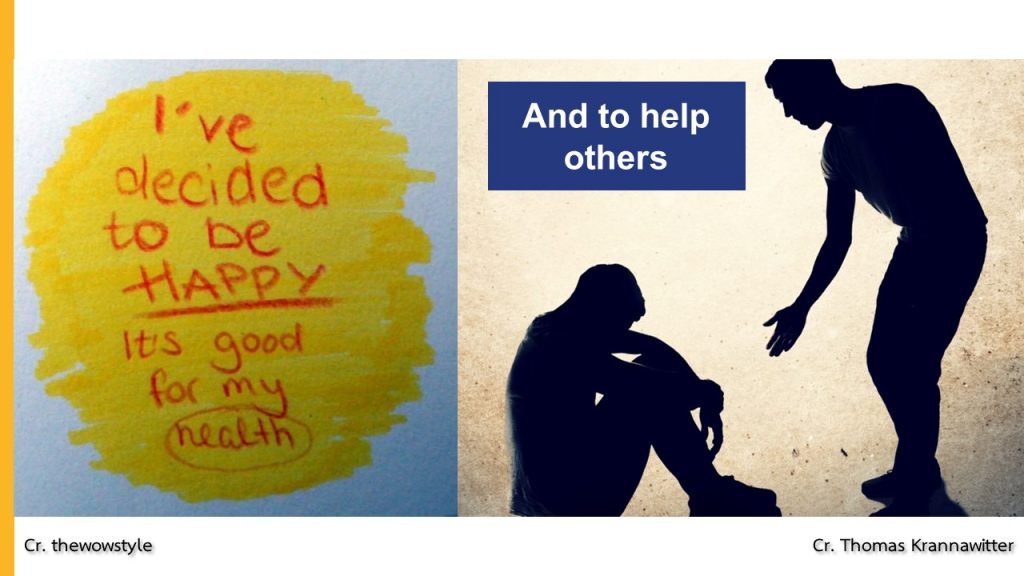
In addition, the Buddha prescribed the layperson’s code of discipline for building and sustaining healthy communities in Worship the Six Directions, the summary of which is that a young man named Sigala used to worship gods in the six directions – east, south, west, north, nadir and zenith – in obeying and observing the last advice given him by his dying father. The Buddha told the young man that in his teaching, the six directions were different. They were: east = parents; south = teachers; west = wife and children; north = friends, relatives and neighbors; nadir = servants, workers and employees; and zenith = religious men. “One should worship these six directions,” said the Buddha, “by performing one’s duties toward them.” For the details of the Buddha’s teachings to Sigala, see here and here.
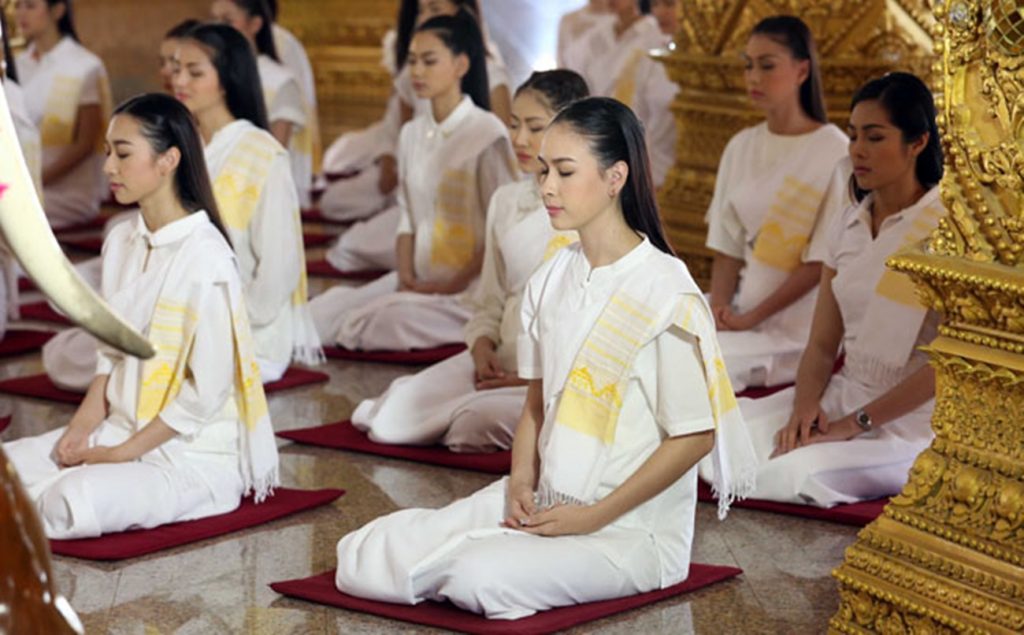
Thai women practice Mindfulness Meditation at a temple (photo credit: https://bit.ly/3nSfElJ)
The Last Stage: Death – When and Where Mindfulness of Death Can Play a Positive Role
In Buddhism, death is defined in The Path of Purification, page 225 as, “the interruption of the life faculty included within (the limits of) a single becoming (existence)”. It is also said in Wikipedia that death is the irreversible cessation of all biological functions that sustain an organism. For organisms with a brain, death can also be defined as the irreversible cessation of functioning of the whole brain, including the brainstem, and brain death is sometimes used as a legal definition of death.
The Buddha compared the inevitability of death with the fall of ripe fruit, saying,
“Just as fruit when ripe is ever fearful of falling off the tree, so too mortals, once born, are bound to pass away.”
Summary of the Concepts of Death in Various Faiths
Since ancient times, many faiths have had a concept of death – at least – to help alleviate emotional loss. Some ancient civilizations and major religions of the world today view death as a natural part of life and a necessary step towards the afterlife where the soul is judged according to its actions in life. Those who have lived a good life on earth are rewarded with eternal life with God the Creator in paradise; those who have lived a bad life are punished in hell. However, Hinduism views death as part of a cycle of birth, death, and rebirth (samsara). The soul is believed to be immortal, and death is merely a passage from one life to the next. The samsara is endless until one, through God, achieves moksha (liberation from this cycle of birth and death).
In a secular context, death is viewed as a natural part of the life cycle, with no religious or spiritual beliefs attached to it. Death is often seen as the end of an individual’s existence, with their body returning to the earth and their consciousness ceasing to exist.
The Buddhist Concept of Death
As for Buddhism, death is a natural and inevitable part of life for all living things. It is a transition point to a rebirth in any of the 31 different planes of existence. This cycle of birth and death continues forever until deathlessness (Nibbana or Nirvana) is attained – through our own effort, and not by way of God.
In the Buddha’s own words on the truth that everyone is bound to die,
“Children, adults, the foolish, the wise, the rich, and the poor all walk towards death.”
Buddhists believe that if we perform good deeds, live a moral and righteous life, and practice spiritual discipline (good karma), we will be reborn in Sugati (Happy destinations meaning a rebirth in the human world or in the heavens) after death. On the contrary, if we commit bad karma, we will have a rebirth in dugati (woeful, unhappy abodes or realms or planes of existence called in Pali apaya – meaning devoid of happiness -, which are the animal world, ghost world, demon-world, and hell). For a detailed description of how a rebirth takes place, see Samsara or Buddhist philosophy of birth and death by Rev. Narada in Buddhistic Studies, pp. 350-364 here.
The Buddhist Views on Causes of Death
From Buddhist points of view, there are four causes of death:
- The expiry of normal lifespan, such as death due to old age – just as the end of average incandescent bulb light span when it is approximately 1,000 hours.
- The cessation of karmic forces. Karmic force or law is the cause and effect order, which conducts one’s life from the embryonic stage towards the day we die. Moral and immoral acts produce desirable or undesirable results.
- The simultaneous exhaustion of the life-span and karmic forces.
- Untimely death or unnatural death.

Rescue workers carry the body of a victim on a stretcher, after a 7.9 magnitude earthquake hit, in Kathmandu, Nepal April 25, 2015 (photo credit: https://bit.ly/42Lwdjn)
On the same cause of death, the World Health Organization (WHO) mentions the top 10 causes of death, such as heart disease and stroke. And this website on the same topic refers to many causes of death. For example, people may die from natural causes such as old age, or from illnesses due to diseases, or from malnutrition, or from accidents, or even from suicide.
The Negative Effects of Death
Death can always cause a devastating loss for those left behind psychologically and physically. It can be a difficult and painful experience to navigate. As a result of the death of a loved one, people usually feel sad, depressed, despair, grief, lonely, and may have trouble sleeping or eating. Furthermore, they may experience a sense of emptiness, a sense of anger – at the person who died, at ourselves, at other people, or at the world in general. They may have a sense of guilt about things they did or did not do; or for surviving when their loved one did not; a sense of shock; loss of interest in things they used to enjoy. In some cases, people may have a sense of relief – particularly at the death of a loved one who may have been suffering or in pain for a long time – even though they love the deceased.
We usually mourn a loved one’s death, as well as the death of individuals we have never met. This is because it is a necessary process of grieving and coping with the loss of someone who was important to us. Socially and psychologically, mourning serves several important functions. For example, it allows people to come to terms with the reality of the loss and beginning to move forward. It also allows people to express their emotions and to receive support from others. And it even helps people to remember and honor their loved one. It can be an important part of the healing process.
At the same time, we also mourn the death of individuals we have never met. It is a reflection of our capacity to connect emotionally with others, to empathize with their experiences and to recognize the impact they may have had on our lives or society as a whole.
The Fear of Death
People usually have a fear of death for a variety of reasons. For example, fear of missing out on life of future experiences, opportunities, and relationships; fear of pain and suffering that can occur during the dying process; fear of leaving loved ones behind and the impact their death will have on them; fear of extinction or non-existence after death; fear of the end of consciousness and the sense of self that comes with it; fear of the unknown after death that can lead to anxiety and fear; and fear of the afterlife, especially for people of some faiths, on being judged or punished after death.
The Buddha advised that we should habitually keep doing good so that we can welcome death, saying,
“Having established oneself in righteousness, one need not fear the hereafter.” and “I have no evil done anywhere at all. I therefore have no fear for the coming death”.
Dr. Ralph Lewis M.D. discloses in Facts to Calm Your Fear of Death and Dying that there is no pain or suffering in death itself. At the time of death, there is cessation of consciousness. And once one has actually died, being dead doesn’t feel like anything whatsoever, obviously. There’s simply no you to do the feeling.
Article in Psychologytoday.com 30 Awe-inspiring Facts About Your Body, citing the book The Body: A Guide For Occupants by Bill Bryson, says that the number of atoms that takes to make us are 7,000,000,000,000,000,000,000,000,000! It seems that there is no “us” at all, there are only atoms. No “we” to die, just atoms to end.
Article in Scientific American Our Bodies Replace Billions of Cells Every Day reveals that the human body replaces its own cells regularly, and in 80 to 100 days, 30 trillion cells will have replenished – the equivalent of a new you. It seems here too that we regularly “die” and “are reborn” every 80 to 100 days!
Accepting Death is Better than Denying it
A recent study on Why We Fear Death and How to Overcome It found that those who were afraid of death were more likely to have prolonged symptoms of grief after losing a loved one compared to those who had accepted death.
The Buddha advised us not to weep or grieve, saying,
“Weeping or grieving will not calm you down. Only your suffering escalates while your body deteriorates.”;
American Psychological Association, citing research, says in its website on Grief: Coping with the loss of your loved one that most people can recover from loss on their own through the passage of time if they have social support and healthy habits.
European Journal of Oncology Nursing’s research on Death acceptance from a Thai Buddhist perspective: A qualitative study finds that understanding death acceptance is important for nurses providing care for patients with terminal cancer in order to find strategies and support for patients to accept death and live peacefully with their family in the time they have left.
The Mindfulness of Death (Maranasati Meditation) is the Perfect Technique to Overcome the Fear of Death
In order to overcome a fear of death and reduce sadness, depression, despair, grief, loneliness, as well as to transform life into a happy mode for ourselves and for the society at this time of difficulty, the Buddha prescribed Maranasati meditation as a remedy – and taught how to do it.
In fact, Maranasati is just one of the 40 subjects of meditation in Buddhism, the three of which are very popular and scientifically proved very useful, namely Mindfulness of Breathing; Loving-kindness meditation, and Compassion Meditation.
The Mindfulness of Death is the practice of recollecting death as the object of meditation. It is aimed at fostering a deep awareness of the impermanence of life, the inevitability of death, and allowing that realization to influence one to live more productively in the present for oneself and the society.
More than 2500 years ago, the Buddha addressed monks in Maraṇasati Sutta, “Monks, mindfulness of death—when developed & pursued—is of great fruit and great benefit.”
This is how to develop and pursue it,
“A monk should reflect daily, “Many are the (possible) causes of my death…. I don’t know when my death will come….’ He should investigate: ‘Are there any evil, unskillful qualities unabandoned by me that would be an obstruction for me were I to die now?’ If, on reflection, he realizes that there are…, then he should put forth extra desire, effort, diligence, endeavor, relentlessness, mindfulness, and alertness for the abandoning of those very same evil, unskillful qualities ….”. But if, on reflecting, he realizes that there are not, then for that very reason he should dwell in joy and rapture, training himself day and night in skillful qualities.”
“This, monks, is how mindfulness of death is developed & pursued so that it is of great fruit & great benefit…”.
On another occasion, the Buddha also advised his followers to think deeply or carefully,
“Phases of life gradually dwindle away on every closing and opening of the eyes. Since phases of life dwindle as they do, separation from one another will occur without doubt. All the remaining beings should be friendly and helpful to one another instead of grieving over the deceased.”
Buddhaghosa, a 5th-century Indian Theravada Buddhist monk commentator and philosopher, elaborated on how to practice Mindfulness of Death in book The Path of Purification (Visuddhimagga in Pali), pp. 225-236, that one should not recollect the [possible] death of an agreeable person lest sorrow arises; should not recollect the death of disagreeable person lest gladness arises; should not recollect the death of neutral people lest no sense of urgency arises; should not recollect one’s own death lest anxiety arises. Instead, one should look at beings that have been killed or have died, and advert to the death of beings already dead but formerly seen enjoying good things, doing so with mindfulness, with a sense of urgency and with knowledge, after which he can exercise his attention in the way beginning, “Death will take place.” By doing so he exercises it wisely.
Atiśa Dīpankara Śrījñāna (982–1054), a Mahayana monk, further advised on how to contemplate on death in this way:
- Death is inevitable;
- Our life span is decreasing continuously;
- Death will come, whether or not we are prepared for it;
- Human life expectancy is uncertain;
- There are many causes of death;
- The human body is fragile and vulnerable;
- At the time of death, our material resources are not of use to us;
- Our loved ones cannot keep us from death;
- Our own body cannot help us at the time of our death.
The above-mentioned discourse and commentaries are meant for monks in order for them to attain Nibbana, but mindfulness of death can definitely be adapted to suit the people, who can use it in daily life. We can adopt the aims of the sermon – great fruit and great benefit –, and adapt by lowering the degree of its practice to that of the layperson’s level.
How to Practice Mindfulness of Death as a Layperson
We may spend about 5-10 minutes a day to practice Maranasati so that we can normally realize the impermanence of life, the inevitability of death, the value of lifetime we have now, the importance of living a good life as much as we can for ourselves and society, the value of doing good things rather than bad deeds; the significance of having no fear of our timely death and even that of others; and the substance of attending the customary mourning as a social animal.
If the degree of intensity of recollection of Mindfulness of Death by a monk is in advanced level, the layperson’s’ degree should be in primary one. This is more than enough, for it can ease the fear of death and dying.
We may also contemplate on these passages (Abhinhapaccavekkhanapatha in Pali) every day:
- We are subject to aging. Aging is unavoidable;
- We are subject to sickness. Illness is unavoidable;
- We are subject to death. Death is unavoidable;
- We are destined to lose and leave our beloved ones and things;
- Due to the law of cause and action (karmic law), we are the owners of our actions, heir to our actions, born of our actions, and live dependent on our actions. Whatever we do – for good or for evil – we are destined to receive the results of what we have done.
- All kinds of living beings surely come to death, they have always died, will always die, in the same way I will surely die, doubt about this does not exist in me.
- Are there any evil, unskillful qualities in us that should be abandoned, or any duties that should be performed … if we were to die now. If, on reflection, we realize that there are, then we should put forth extra alertness, desire, and effort for the abandoning of them. But if, on reflecting, we realize that there are not, then we should live in joy.
- The Buddha’s word,
“Phases of life gradually dwindle away on every closing and opening of the eyes. Since phases of life dwindle as they do, separation from one another will occur without doubt. All the remaining beings should be friendly and helpful to one another instead of grieving over the deceased.”
Scientifically Proven Benefits of Maranasati Meditation
Nikki Mirghafori, Ph.D. in computer science and an AI researcher, mentions in The Surprising Benefits of Contemplating Your Death that recollecting death can reduce anxiety and suffering it brings into our lives.
Mindfulness and Death in Psychologytoday.com by Jason N. Linder, Psy.D. mentions that awareness of death can sharply improve quality of life, for example, it is a potent doorway into gratitude.
Maranasati Meditation: How to Practice Mindfulness of Death in Positivepsychology.com by Jo Nash, Ph.D., citing research, says that this meditation has a lot of benefits. For example, it can reduce the suffering of attachment and emotional reactivity to change; increase sense of gratitude for each moment of our precious human life; enhance appreciation of human vulnerability that leads to greater compassion for self and others as well as deepen appreciation of the intrinsic value of life; diminish anxiety about death, the death of our loved ones, and dying in the world around us; and help us to support others during their dying process and friends and family who are grieving.
Grief: Coping with the Loss of Your Loved One by American Psychological Association, advises that people should remember and celebrate anniversaries of a lost loved one to help reduce the fear of death.
Thai People Remember the Deceased Relatives and Make Merits for Them Who are in Another Plane of Existence in Separate Two Occasions Annually
It is a Buddhist tradition that we remember our deceased relatives and make merits for them who live in another realm of existence. Although we do not know where he or she is, we usually make merit and transfer it to him or her twice a year: during Songkran festival and Sārd (Giving merit to the departed).
On both occasions, Buddhists go to the temple, offer food to Buddhist monks, and request them to perform a rite for the deceased. The rite can be performed en masse in a temple hall, or privately in front of an urn or another form of container with the bone of the deceased inside. When the relatives of the deceased and the monks are ready, the latter solemnly, softly chant Pali words about the natural impermanence of life and the inevitability of death. The last part of the rite is to dedicate the merit to the deceased. For this year, Songkran Festival will be celebrated on 13-15 April, and Sārd Rite will be observed on 14 October.
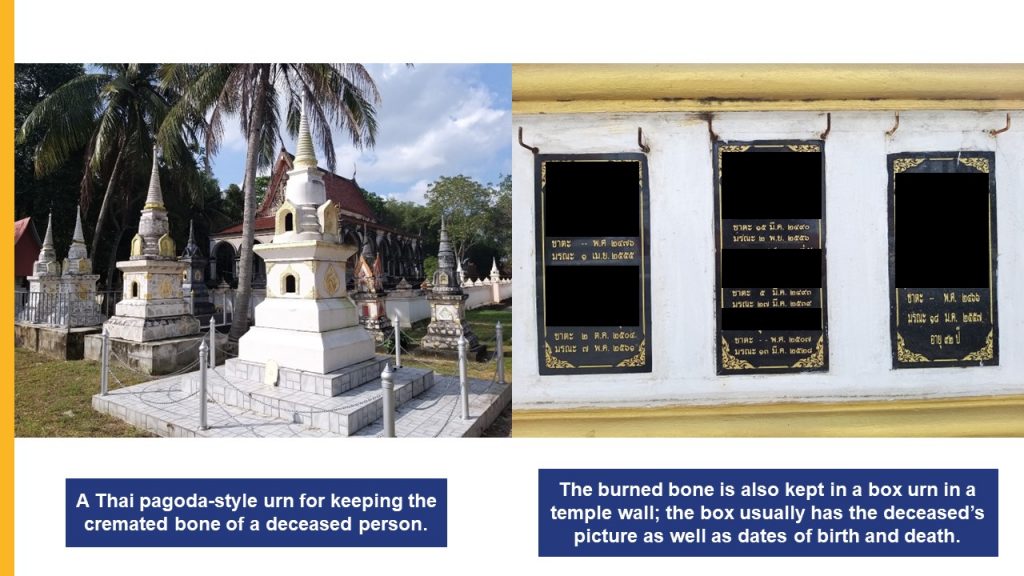
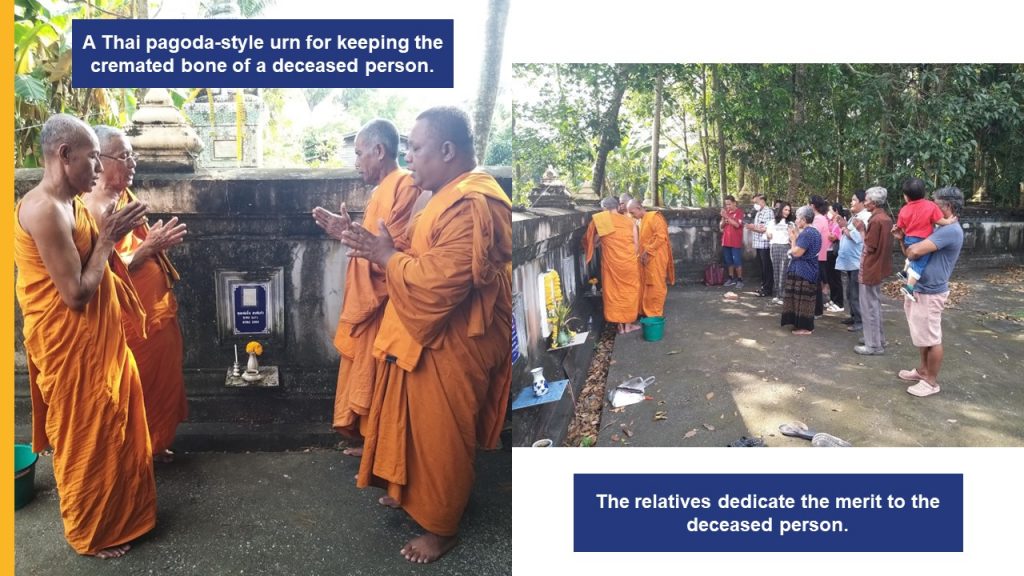
Conclusion
Death is a phase of life, rather than the end of life. It is a dormant phase of life, just as birth is the phase when life becomes active and manifests again in the physical world. Each individual life can be likened to a wave in the ocean. When a wave rises from the ocean, that is life, and when it merges back into the ocean, that is death. This process continues eternally, without beginning or end. It is just the birth-and-death twins.
Mindfulness of Death should fill us with a sense of the preciousness and fragility of this life. It should inspire us and motivate us to live life to the fullest, with a sense that we should not waste our days – to experience, to learn, to grow, to connect, and to contribute to those around us.
In the inspiring, true words of the Buddha:
“Phases of life gradually dwindle away on every closing and opening of the eyes. Since phases of life dwindle as they do, separation from one another will occur without doubt. All the remaining beings should be friendly and helpful to one another….”
“The doer of good rejoices in this world.
He rejoices in the next world.
He rejoices in both worlds.”
“Grain, wealth, silver, gold, or whatever other cherished possessions there are; slaves, workers, employees, and dependents; none of these can one take away, everything must be left behind. But the karma one has done by body, speech or mind: these are truly one’s own, these one takes when one goes. Kamma follows one along like a shadow that never departs.”
“Therefore, one should do what is good, accumulating what is useful for the future. Merits are the support for living beings in the world to come.”
“Hasten to put forth effort today; death may come tomorrow, who knows?”
Bibliography
- apa.org (American Psychological Association-APA)
- Buddhaghosa. The Part of Purification (Visuddhimagga), translated from Pali by Bhikkhu Nanamoli). Singapore Buddhist Meditation Centre.
- buddha-vacana.org
- encyclopediaofbuddhism.org
- Death and mourning – Practices in Buddhism – GCSE Religious Studies Revision – Eduqas – BBC Bitesize
- Law, Bimala Churn. Buddhistic Studies. Low Price Publications, Delhi. 2004.
- learnreligions.com
- Manivamso (Maneewong), Phramaha Pisit. The Analystical Study of Maranasati in Theravada Buddhism. Mahachulalongkornrajavidyalaya University, Bangkok, Thailand, B.E.2553 (C.E. 2010).
- Payutto, Bhikkhu P.A. Buddhadhamma: The Law of Natures and Their Benefits to Life. Buddhadhamma Foundation, Bangkok, Thailand. 2018.
- Payutto, Bhikkhu P.A. Dictionary of Buddhism พจนานุกรมพุทธศาสตร์ ฉบับประมวลธรรม. 2022.
- Payutto, Bhikkhu P.A. The Nectar of Truth: A Selection of Buddhist Aphorisms (อมฤตพจนาพุทธศาสนสุภาษิต), translated from Thai by Prof. Dr. Somseen Chanawangsa. 2013.
- Pali recitation with English translation, Samnak Song Pacha Lilai, Kelantan, Malaysia, Forth Edition. 2013.
- PositivePsychology.com – Helping You Help Others
- Psychology Today: Health, Help, Happiness + Find a Therapist
- Verywell Mind – Know More. Live Brighter.
- wikipedia.org
- wisdomlib.org
- worldometers.info
____________________________________________________________________________________________
Author: Paitoon Songkaeo, Ph.D.
12 April 2023


